Capitol Hill, relics of doubtful antiquity. Monument to Marcus Aurelius
The Capitol is perhaps the most famous of the hills of Rome. Everyone heard this name at school and most quickly everyone heard the legend of the Capitoline she-wolf who nursed Romulus and Remus, and saw her image in a photograph in a history textbook. The most diligent students probably remember the temple of Capitoline Jupiter and his wife Juno. In antiquity, these were the most beautiful and richest temples in the world. When a general celebrated a victory, he rode down the Via Sacra to the Capitol, dressed as Jupiter, in a chariot drawn by white horses.
But I will disappoint you, no ancient buildings on the Capitol have been preserved to this day. All former splendor has sunk into oblivion. The great temple of Jupiter collapsed and spilled over the hillside. Life returned here again only a few centuries later, when a church dedicated to the Holy Virgin Mary was built on the site of the former temple of Juno, and a fortified palace of the magistrate was erected not far from the former temple of Jupiter.
And yet the Capitoline Hill is no less beautiful today than it was in antiquity. The Capitoline Square was built up in the 15th century according to the design of Michelangelo Buonarroti with three most beautiful palaces and decorated with "antique" statues.
The most convenient way to get to the Colosseo metro station is on the blue line and walk along Via Imperiale for about 1 km past the Colosseum, the Roman Forum and the Forum of Trajan. Capitol Hill will be hidden from you by a massive monument to Victor Emmanuel II. As soon as you go around it, you will immediately see two stairs leading to the Capitol.
Buses No. 40, 170, 492 run from Termini Station. You need to get off at Piazza Venezia, as soon as you see the monument to Victor Emmanuel II, it is so huge that you cannot confuse it with anything.
If you stand facing the monument, then the Capitol will be on the right.
Now there is a busy street in front of the legendary hill, along which buses, cars, motorcyclists scurry back and forth, and probably the inhabitants of Rome are so used to the landscape around them that they stopped paying attention to it. Just like me, driving along the Palace Bridge in St. Petersburg I am more concerned about the presence or absence of traffic jams than the architectural ensemble surrounding me. That's why we travel, to go beyond the usual and throw a new look at the world.
I guarantee you a new look, I will not rewrite the platitudes that the symbols of Rome are 2000 years old, because the Eternal City, how could it be otherwise. I will tell you about new historical data, not yet very popular, but still taking place. The solid age of historical relics is in question. What is written in a school history textbook is not the ultimate truth, it is just one of the versions.
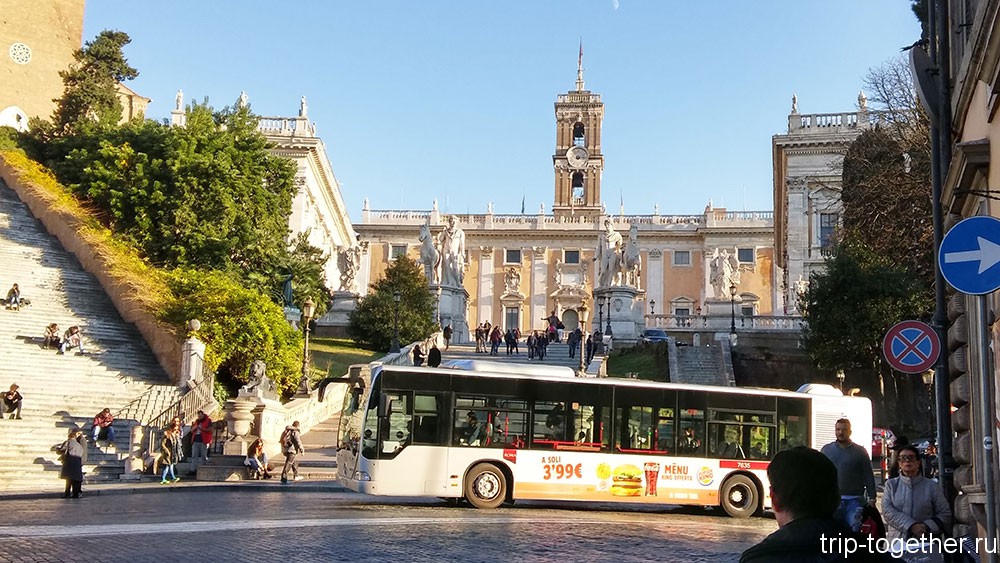
Capitol Hill, stairs to the church of Santa Maria in Araceli on the left
There are two staircases leading up to Capitol Hill. One of them will take you to the square, it is called Cordonata, and the second to the church of Santa Maria in Araceli. My greatest surprise was the fact that it is impossible to go from the church to the square, you have to go down the hill again and climb another staircase. From the Forum side, you can also climb the hill along a quiet highway intended for magistrate employees, but this will be more a back door than a front door.
Statues of the Dioscuri
The entire ensemble of the Capitoline Square was created in 1536-1546 according to sketches by Michelangelo. Those ascending the hill are met by sculptures of the Dioscuri - Castor and Pollux (otherwise it is called Polydeuces). These statues, like many others, were found during excavations in the 16th century and are considered antique.
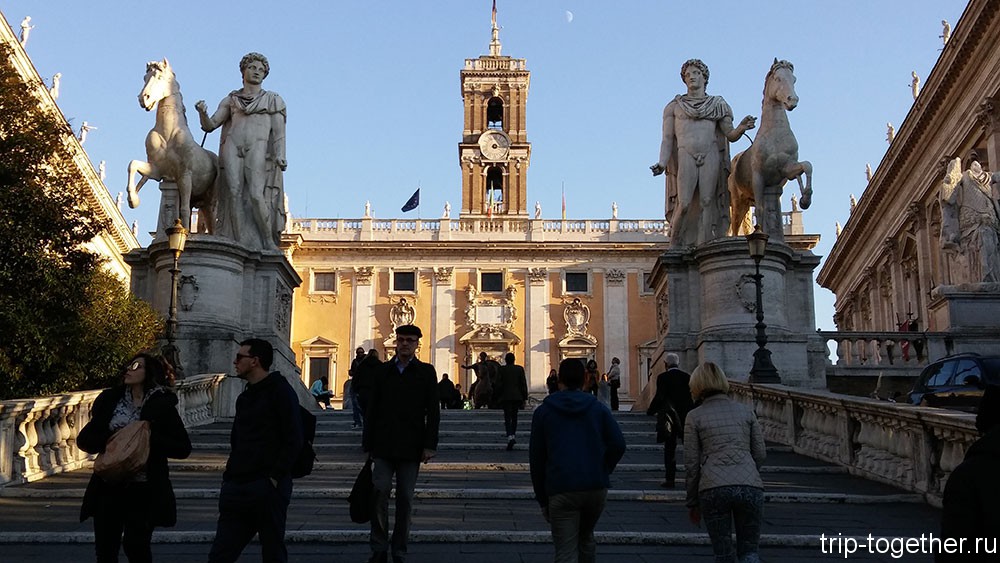
Dioscuri - Castor and Polydeuces, in the background the Palazzo Senators
Dioscuri - strange twin brothers gave their name to the constellation Gemini. They were born as twins, but they had different fathers, one of them was immortal, the other mortal. modern science such facts about twins with different fathers are not known, but this is a myth. According to myths and legends, the brothers took part in the campaigns of the Argonauts and Trojan War. And on their heads they wore hats-caps in the “shape of a cone from an egg” (quote from Wikipedia), new chronologists would definitely see in these hats a Scythian, and in their opinion, a Russian trace.
Huge statues of the Dioscuri are also installed on the Quirinal Hill, and the ruins of a temple dedicated to the brothers Castor and Pollux have been preserved in the Forum. Obviously, they were very revered in Rome.
Equestrian statue of Marcus Aurelius
In the center of the square stands one of the symbols of Rome, a copy of the antique bronze statue of Marcus Aurelius. The original is now in the Capitol Museum. The fact that the statue belongs to Marcus Aurelius is quite controversial, it’s just that everyone is used to calling it by that name.
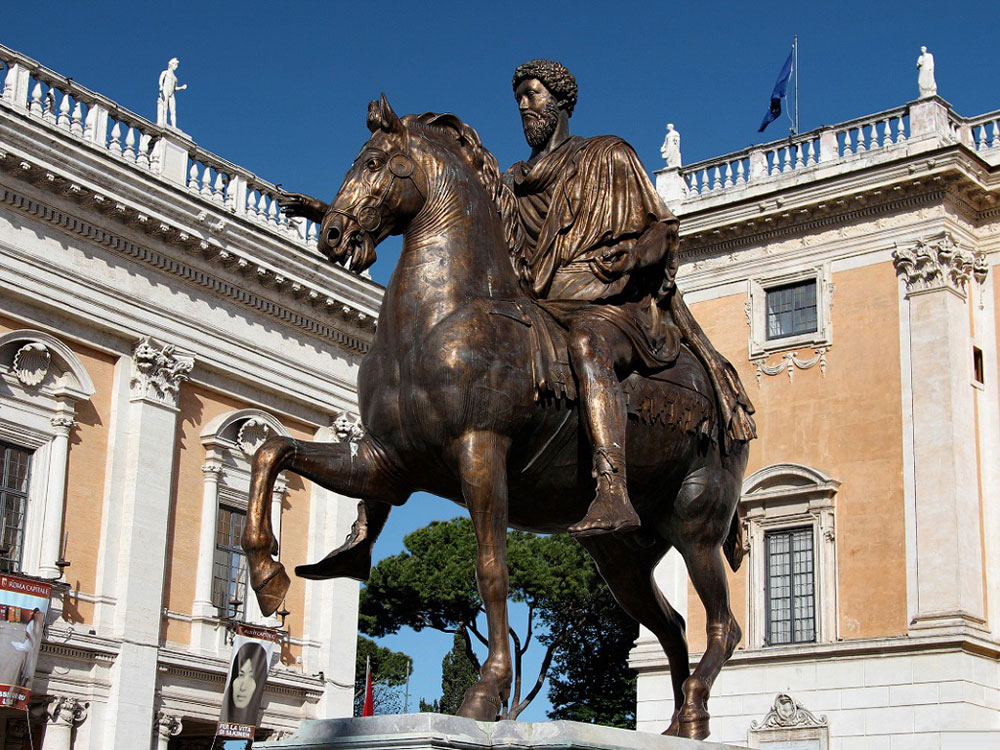
Copy of the statue of Marcus Aurelius in the square
The statue is unsigned and has never been signed, it was previously believed that it was Emperor Constantine, and it was attributed to Marcus Aurelius based on a comparison with a portrait on a signed coin in the 12th century. The similarity is quite controversial and approximate in view of the rather rough execution of the imprint on the coin.
The website of the Capitol Museums states that ancient authors do not mention this particular statue, but there are mentions of other 22 equestrian statues much larger than this one, which have not survived to this day. There is also a mention of this statue by the medieval scholar Ricobald from Ferrara. He claims that the statue was cast by order of Pope Clement III (pontificate years 1187-1191). In general, the inconsistencies with determining the age of this statue on the face, the XII century does not pull on antiquity in any way.
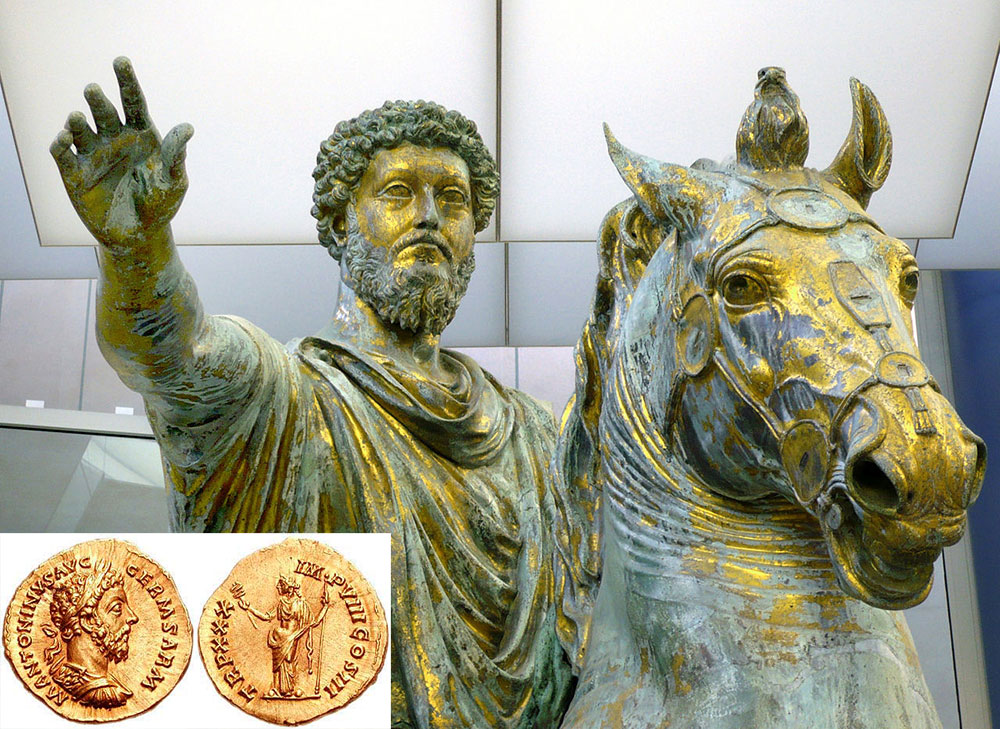
Bronze gilded original statue of Marcus Aurelius and a coin (photo from Vicki)
A marble bust and a pair of bas-reliefs depicting the same man are kept in the Capitol Museums. Not far from the Capitoline Hill on the Column Square stands the Antoninus (Marcus Aurelius) column, made in the spirit of Trajan's column, i.e. all covered with bas-reliefs, but without a single signature. He was definitely famous ancient world. Peru Marcus Aurelius also owns philosophical treatises written in Greek and in some ways repeating the principles of Christian morality.
Perhaps Ricobald of Ferrara was right and Marcus Aurelius lived already in the 11th-12th centuries, and only a little later than the death of the emperor, Pope Clement III decided to perpetuate his ebb of this beautiful sculpture? Then the writings of Marcus Aurelius in the spirit of Christian values look quite natural. Or right modern historians who believe that Ricobald did not understand anything about the events surrounding him? But the ancient chronicler was closer to them by 5-6 centuries.
The equestrian statue of Marcus Aurelius was replicated with different riders around the world, we can say this image of a horse and a rider is a classic of sculpture. In St. Petersburg there is a monument to Peter I in a similar pose, Jozef Poniatowski froze in the pose of Marcus Aurelius in front of the presidential palace, there are analogues in the USA and Great Britain.
Capitoline she-wolf
To the left of the Palace of the Senators is a copy of the sculpture of the Capitoline she-wolf. The original, after a recent scandalous restoration, is kept in the Capitol Museums. During the restoration, metallurgy specialist Anna Maria Carruba found that the she-wolf statue was cast in its entirety. Antique bronze sculptures were usually cast in parts, and then soldered, the ancients were not able to work with large volumes of molten metal. This fact shifts the date of manufacture of the sculpture from antiquity to the Middle Ages. The traditional date is 500 BC. supported by ancient authors, but they described a completely different sculpture - a she-wolf licking babies.
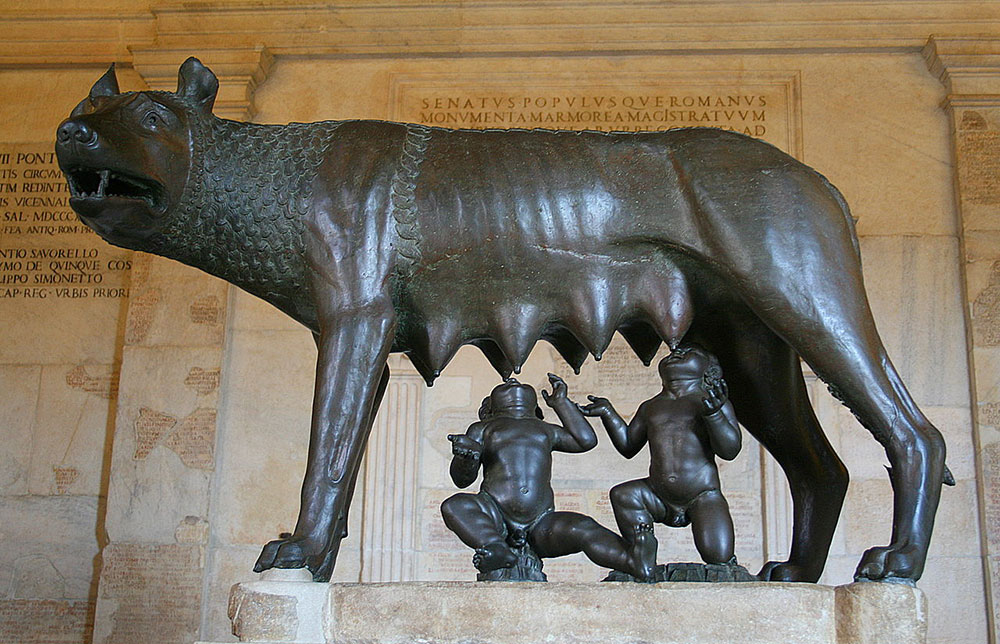
The original sculpture of the Capitoline Wolf in the Capitol Museums (photo from Wikipedia)
Babies were made quite officially in the 15th century, this fact is documented and the name of the sculptor is known. However, despite all the statements of Anna Maria Carruba, the plate with the date of manufacture of the she-wolf figure in the Capitol Museum was not changed.
It is curious that this was the first and only restoration of the sculpture, and it was assumed that it was 2500 years old. I live in St. Petersburg. In my city, too, there are quite a few bronze sculptures, and the city is only 300 years old, but the sculptures are regularly repaired, we are shown this on local television. Even the angel, installed on the Alexandrian Column for less than 200 years, was repaired. Are the sculptures in Rome so durable that they don't need to be repaired?
It would be interesting to know about the results of the restoration of the sculpture of Marcus Aurelius, it was carried out, but the only thing I could find about this was statements that the restoration was equated with a secret operation, a limited number of people were allowed in and they did not give any comments.
The statue of the Capitoline she-wolf is replicated even more than the statue of Marcus Aurelius. We personally saw her also in. All its copies installed around the world are even difficult to count.
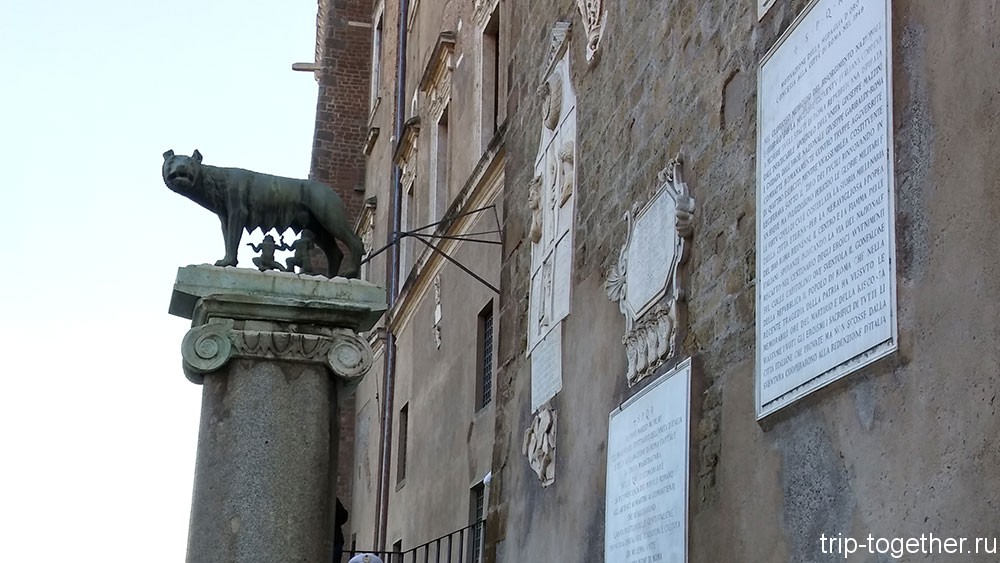
Capitoline she-wolf
On the wall next to the she-wolf, there are numerous memorial plaques praising the activities of the Popes in the restoration and repair of buildings on the Capitol Hill, the holy fathers did not forget to perpetuate, first of all, their loved ones. Many plates contain the abbreviation S.P.Q.R. - "Senatus Populus que Romanus" ("The Senate and Citizens of Rome"), although they no longer refer to the times of ancient Rome. The ancient abbreviation S.P.Q.R. with success began to be used in united Italy and I still use it right up to decorating Roman hatches with it.
Mussolini really liked the idea of restoring the empire, so the symbols ancient rome, such as the Capitoline Wolf or the abbreviation S.P.Q.R. widely used by his propaganda.
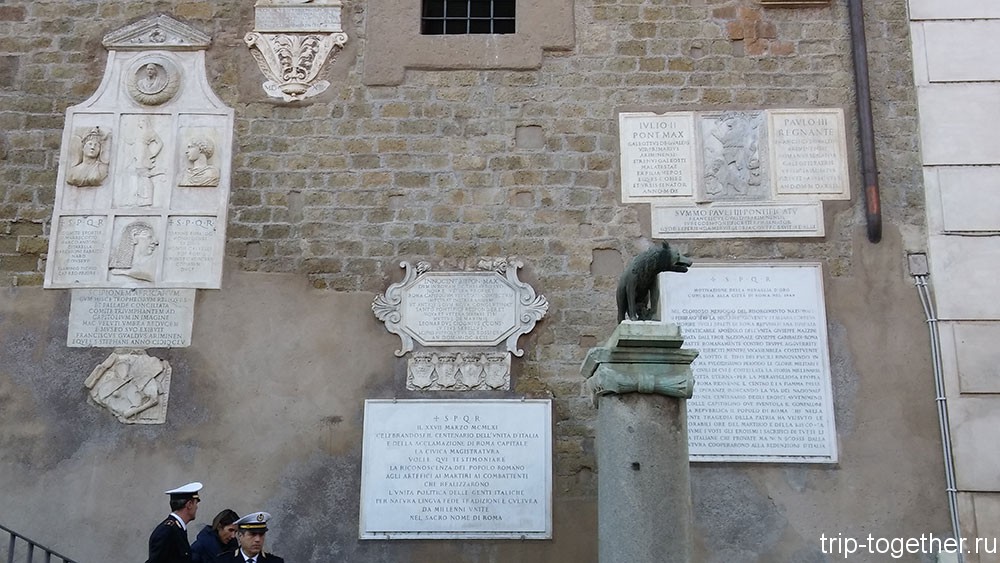
Capitoline she-wolf
Very close to the Wolf is an absolutely wonderful viewpoint. It offers a breathtaking view of the Forum, Palatine Hill and even the Colosseum. Three columns on the right are just the remains of the temple of the Dioscuri, especially revered in Rome.
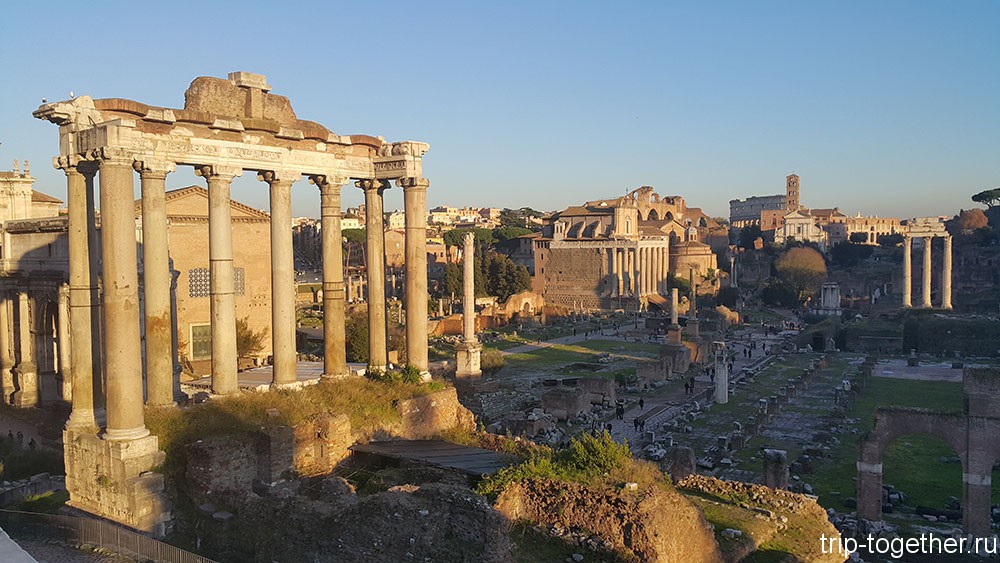
Roman Forum, view from the Capitoline Hill, at the very end of the Colosseum
Museums of the Capitol
The Capitol Museums have a very decent website, all the exhibits are carefully photographed, you can visit the museum virtually and get an idea of \u200b\u200bwould you like to pay 15 euros for a ticket and see the exhibits in full size. There were no queues to these museums in December. We didn't go there.
Museums are located in three palaces - the Palazzo Conservatori, the Palazzo Senators and the Palazzo Nouveau, located around the square.
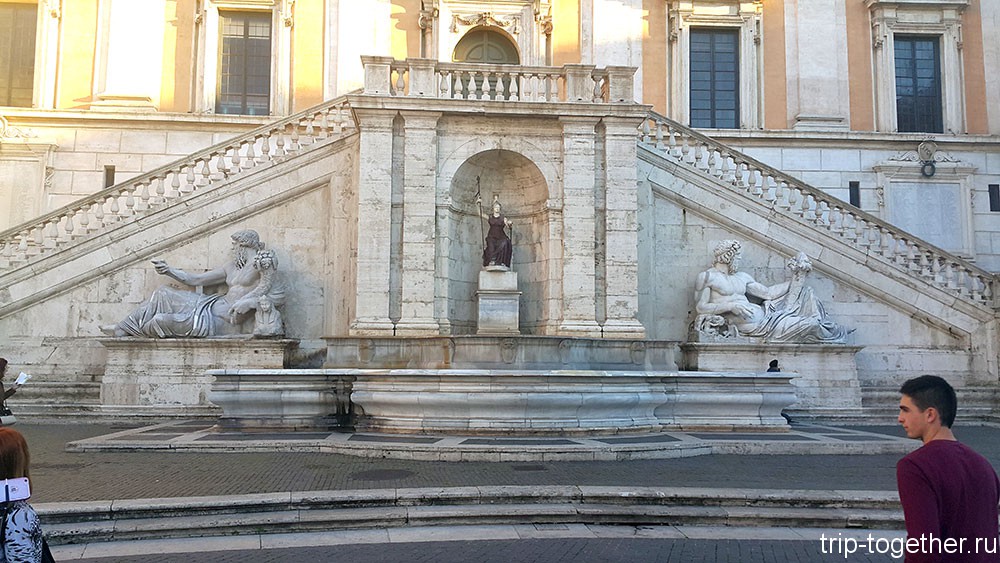
Staircase of the Palazzo Senators
That's actually all about the front part of Capitol Hill. There are still administrative buildings in the entrance hall, and there is a completely different, non-tourist life going on there. Therefore, now we will go down to climb another staircase leading to the church of Santa Maria in Araceli.

Red brick building - Santa Maria in Araceli
On the descent, we noticed a statue at first glance, some kind of monk, but it turned out not to be so. The sculpture is intended to recall the political figure of the Middle Ages Cola di Rienzo (1313-1354, years of life). He was of low birth, but had the gift of an actor and leader of the nation.
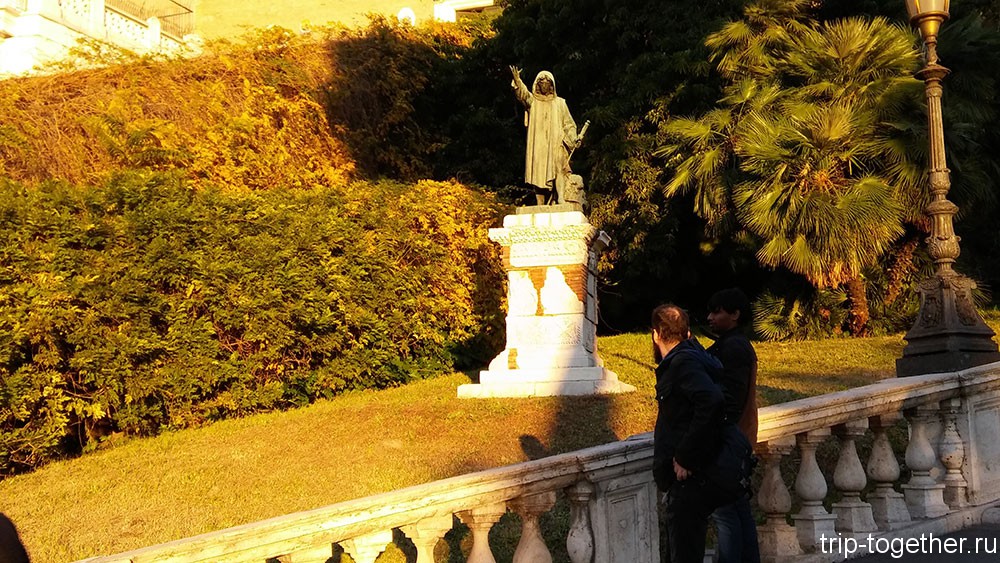
Monument to Cola di Rienzo in Rome
His fiery speeches were a success with the townspeople and at one fine moment Rienzo managed to lead the uprising and become essentially the dictator of Rome, he himself, of course, called himself a people's tribune. His transformations were very useful, the arbitrariness of the barons and robbers began to decline, but nothing lasts forever. The moment came when the offended barons unleashed their wrath on him. It is believed that Rienzo was killed on the very spot where the monument now stands.
And finally, amazing - blooming cyclomenes at the foot of Capitol Hill in December.

cyclomenes
And a cross between a car and a scooter, the Renault Twizy electric car. They say that it is a double seat, but I still don’t understand where the second person is invited to sit, there is only one seat, and there’s nowhere to put the bags from the supermarket.
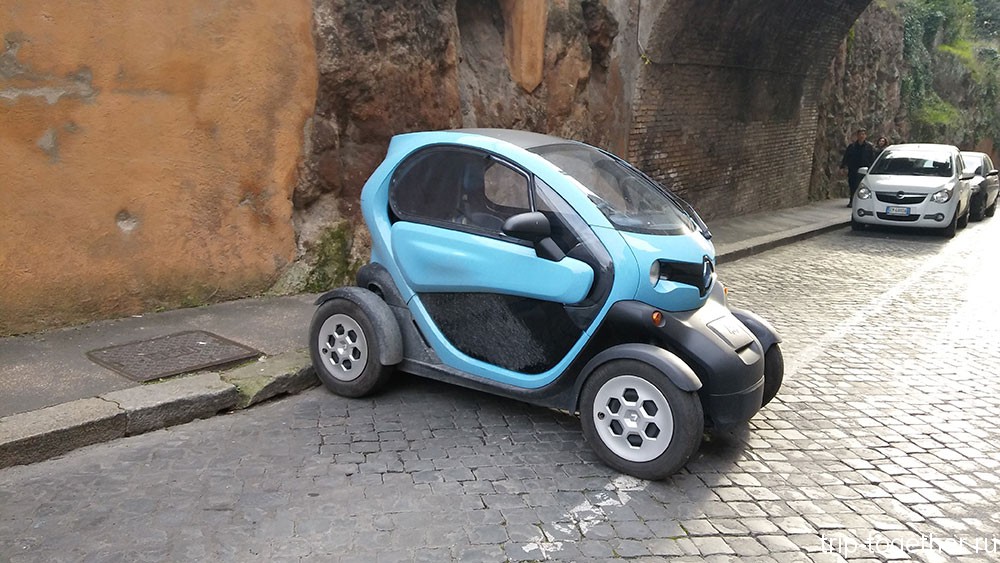
Little Renault on Capitol Hill
In the next article I will tell you, she also stands on Capitol Hill. I thought to fit it into this article, but it turned out to be very long. The church is worthy of overcoming 124 steps made and stones mined in the Colosseum and the Circus Maximus for its sake. A splendid interior awaits you interesting story about the figurine of the baby Christ, nicknamed "Bambino", all studded with diamonds.
- ancientrome.ru/art/artwork/img.htm?id=667
- www.turim.ru/approfondimento_campidoglio.htm
An excerpt characterizing the equestrian statue of Marcus Aurelius
The military council, at which Prince Andrei failed to express his opinion, as he hoped, left an unclear and disturbing impression on him. Who was right: Dolgorukov with Weyrother or Kutuzov with Langeron and others who did not approve of the plan of attack, he did not know. “But was it really impossible for Kutuzov to directly express his thoughts to the sovereign? Can't it be done differently? Is it really necessary to risk tens of thousands and my, my life because of court and personal considerations? he thought."Yes, it's very possible they'll kill you tomorrow," he thought. And suddenly, at this thought of death, a whole series of recollections, the most distant and most sincere, rose in his imagination; he remembered the last farewell to his father and wife; he remembered the first days of his love for her! He remembered her pregnancy, and he felt sorry for both her and himself, and in a nervously softened and agitated state he left the hut in which he stood with Nesvitsky, and began to walk in front of the house.
The night was misty, and moonlight shone mysteriously through the mist. “Yes, tomorrow, tomorrow! he thought. “Tomorrow, perhaps, everything will be over for me, all these memories will no longer exist, all these memories will no longer have any meaning for me. Tomorrow, maybe, even probably tomorrow, I foresee it, for the first time I will finally have to show everything that I can do. And he imagined the battle, the loss of it, the concentration of the battle on one point and the confusion of all commanding persons. And now that happy moment, that Toulon, which he had been waiting for so long, finally appears to him. He firmly and clearly speaks his opinion to both Kutuzov, and Weyrother, and the emperors. Everyone is amazed at the correctness of his ideas, but no one undertakes to fulfill it, and so he takes a regiment, a division, pronounces a condition that no one should interfere with his orders, and leads his division to a decisive point and alone wins. What about death and suffering? says another voice. But Prince Andrei does not answer this voice and continues his successes. The disposition of the next battle is made by him alone. He bears the rank of army duty officer under Kutuzov, but he does everything alone. The next battle is won by him alone. Kutuzov is replaced, he is appointed ... Well, and then? another voice says again, and then, if you are not wounded, killed or deceived ten times before; well, then what? “Well, and then,” Prince Andrei answers himself, “I don’t know what will happen next, I don’t want and I can’t know: but if I want this, I want glory, I want to be famous people I want to be loved by them, then it's not my fault that I want this, that I want this alone, for this alone I live. Yes, for this one! I will never tell anyone this, but, my God! what am I to do if I love nothing but glory, human love. Death, wounds, loss of family, nothing scares me. And no matter how dear and dear to me many people are - my father, sister, wife - the people dearest to me - but, no matter how terrible and unnatural it seems, I will give them all now for a moment of glory, triumph over people, for love for to myself people whom I do not know and will not know, for the love of these people, ”he thought, listening to the conversation in Kutuzov’s yard. In the yard of Kutuzov, the voices of orderlies packing up were heard; one voice, probably the coachman, teasing the old Kutuzovsky cook, whom Prince Andrei knew, and whose name was Tit, said: “Tit, and Tit?”
Statue of Marcus Aurelius - Roman emperor and philosopher - an ancient Roman bronze statue, which today is located in the Capitoline Square in Rome. It was created in the years 160-180 and today is one of the most frequently visited attractions.
Story
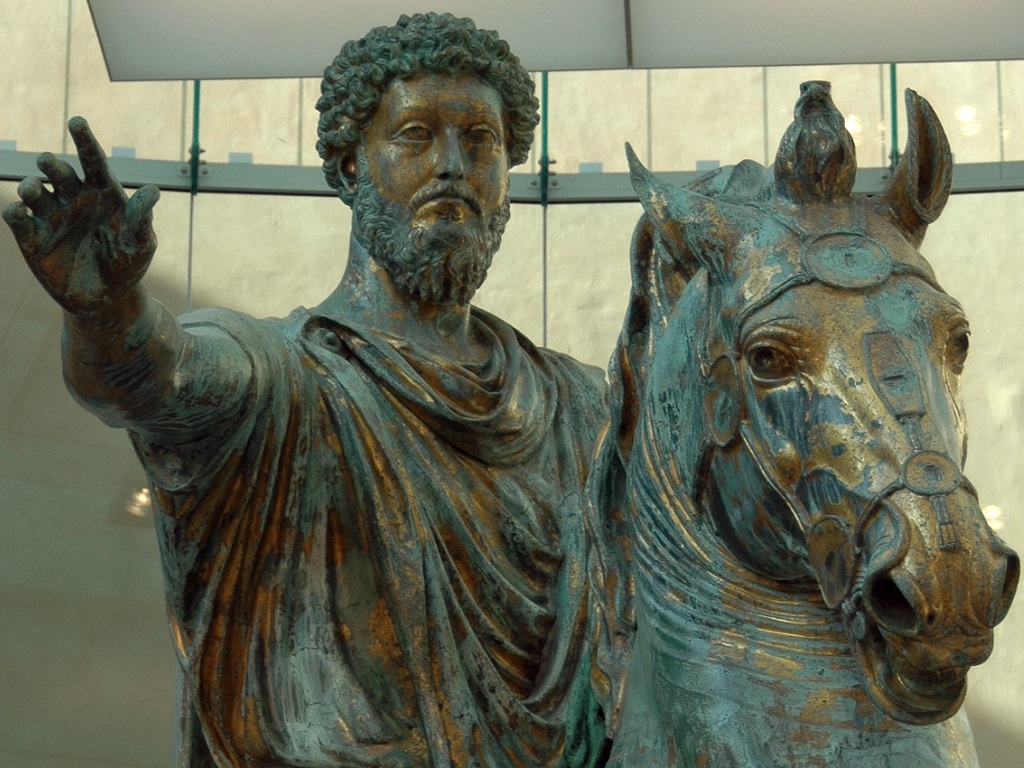
In the twelfth century, a statue of Marcus Aurelius was placed in front of the main residence of the popes - the Laretan Palace. In 1538 it was installed on the Capitoline Square. Almost immediately, Michelangelo Buonarroti began its reconstruction. The work lasted more than one hundred and twenty years, and as a result, the square with three palaces became a magnificent architectural ensemble - one of the brightest sights of Rome.
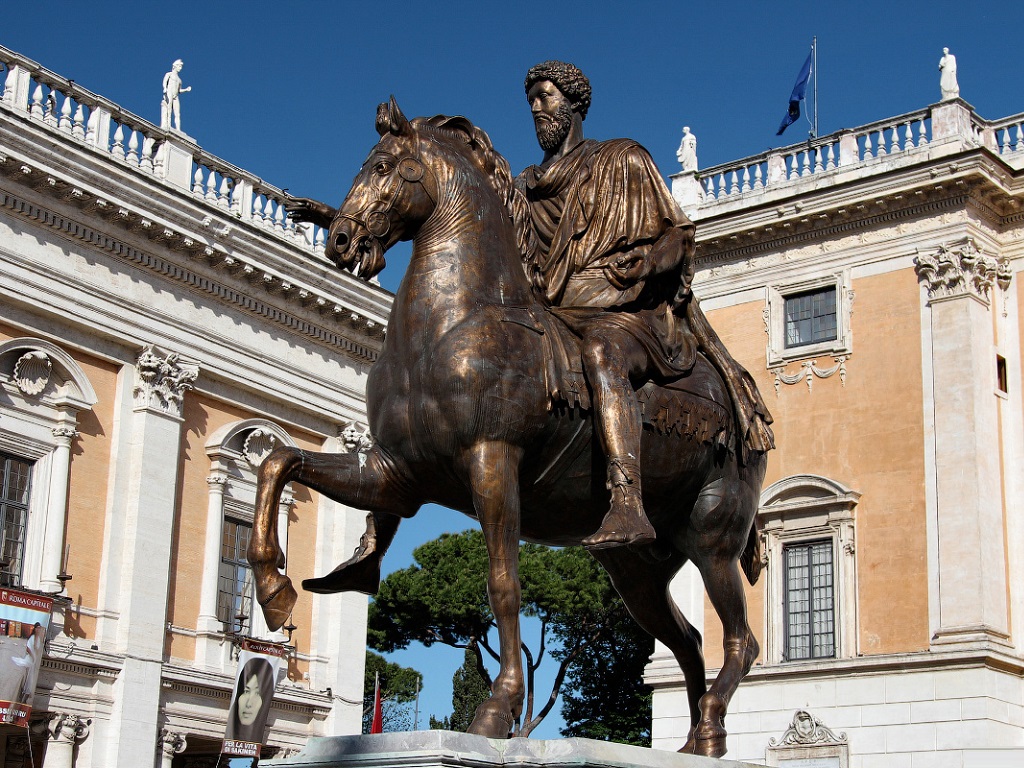
In the Middle Ages, the equestrian statue of Marcus Aurelius was mistaken for the statue of Constantine the Great. The church canonized this emperor as a saint, which saved the monument from destruction, when God's servants called the sculptures created during the time of pre-Christian rulers pagan idols and ordered them to be destroyed.
Copy
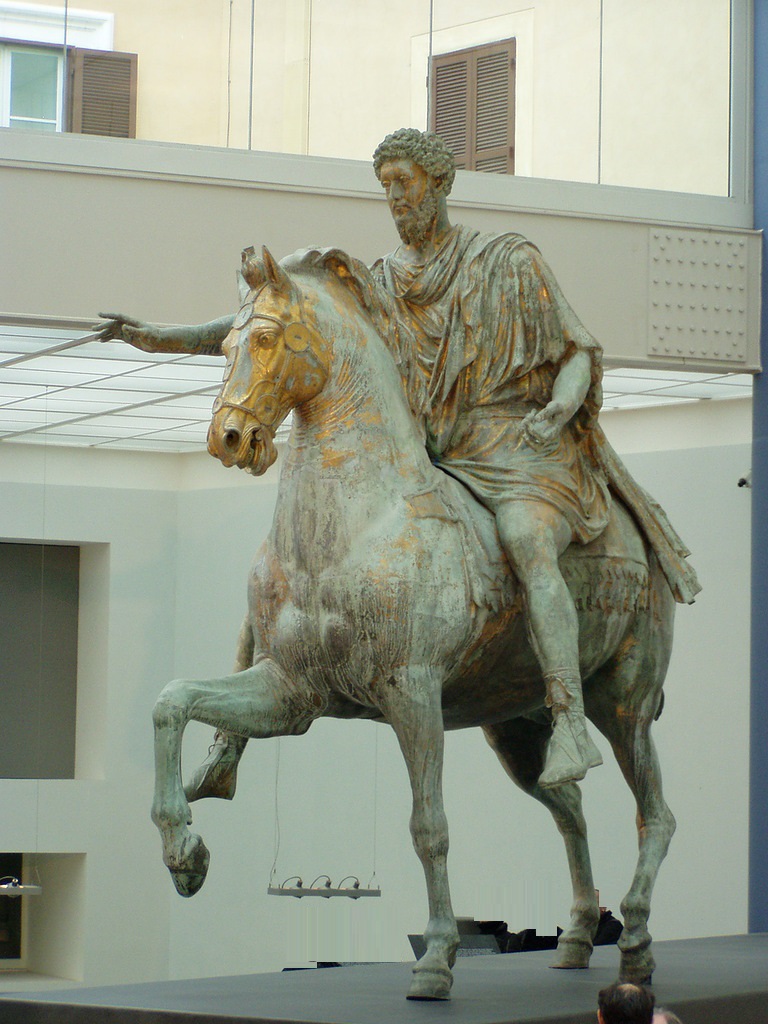
At the end of the nineteenth century, an exhibition hall was built for the statue in the Palace of the Conservatives, which is located on Capitoline Square, and a copy was placed on the square itself. Today, the equestrian statue of Marcus Aurelius in Rome attracts the attention of tourists from all over the world.
Description

The statue of Marcus Aurelius in Rome is made of gilded bronze and is the only sculpture of this type that has survived from ancient times. The emperor is depicted wearing a tunic and a soldier's cloak. The composition of the statue is very simple and concise. Marcus Aurelius is depicted not only as a great victorious emperor, but also as a philosopher-thinker. Mark's face is realistic with bulging eyes and protruding cheekbones. The head is tilted forward, the lips are tightly compressed. The emperor's eyes are half covered with upper eyelids. The hairstyle shows a spectacular play of light and shadow, which sets off the outward calmness and concentration of Marcus Aurelius.
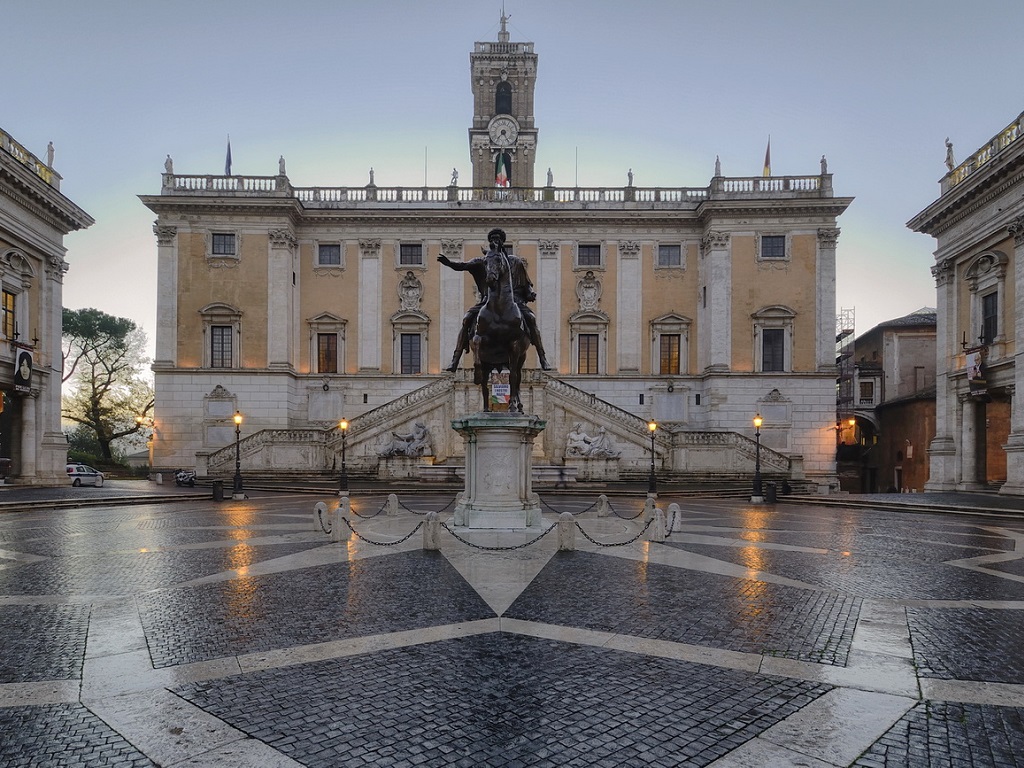
Under the raised hoof of the horse, there used to be a figure of a bound barbarian. She was considered a symbol of a defeated enemy, and the gesture of Aurelius meant generosity to the vanquished.
The statue of Aurelius does not have that pretentious solemnity and grandeur that are inherent in the images of other rulers of Rome. In the portrait of the emperor, the master accurately revealed the mood of a person who feels the contradictions of the reality around him and seeks to escape from them into the world of his own experiences.
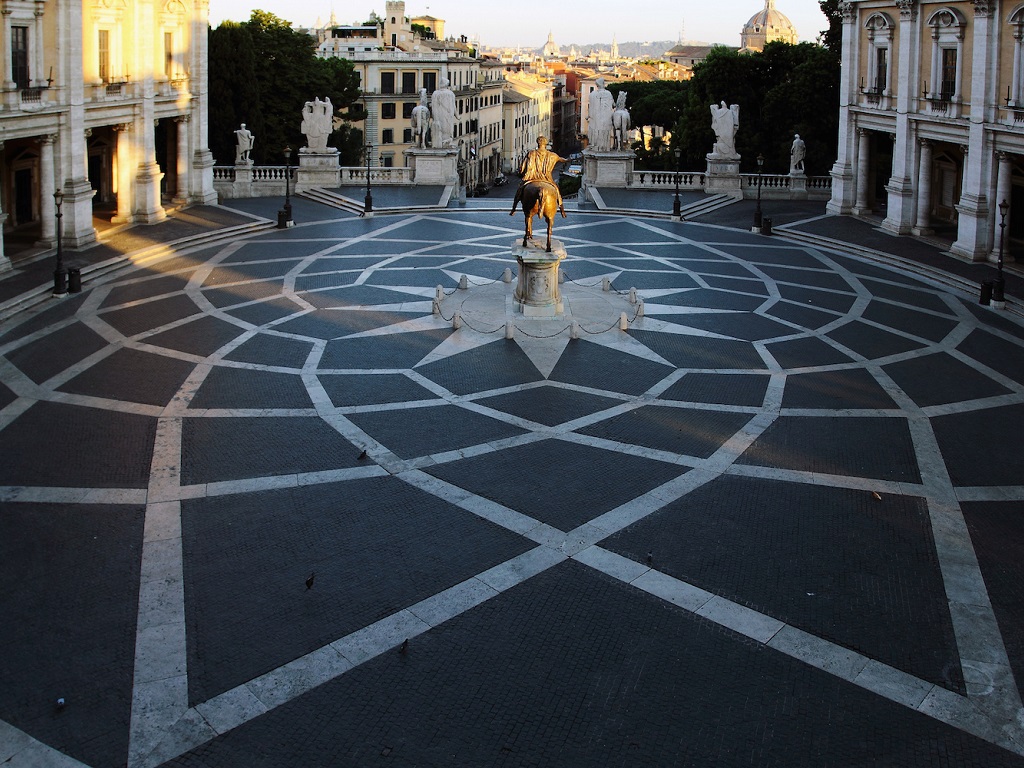
- The statue of Marcus Aurelius is considered the prototype of many equestrian monuments erected in subsequent periods, including Peter I at the Mikhailovsky Castle.
- The statue survived the devastating raids of the barbarians and the religious fanaticism of Christians and has come down to us in its original form.
- The statue is depicted on the reverse of the Italian fifty cent coin.
- A copy of the statue in 1908 was installed in the courtyard of one of the most prestigious North American universities - Brown University (Rhode Island).
- Initially, the statue had a gold coating. An ancient local legend says that it will turn golden again on the Day of Judgment.
8. The evolution of Roman statuary
portrait. Equestrian statue of Mark
Aurelius. late antique painting
(Pompeii, Herculaneum, Stabiae)
Glyptothek (collection of busts) / Roman sculptural portrait - one of the most significant periods in the development of the world portrait, covering about five centuries (I century BC - IV century AD), is characterized by extraordinary realism and the desire to convey character depicted; in ancient Roman fine art, in terms of quality, it occupies one of the first places among other genres.
It is distinguished by a significant number of monuments that have come down to us, which, in addition to art, have significant historical value, as they complement written sources, showing us the faces of participants in important historical events. According to researchers, this period laid the foundation for the subsequent development of the European realistic portrait. The vast majority of the images are made in marble, there are also bronze images that have come down in smaller numbers. Although many Roman portraits are identified with specific individuals or have an explicit inscription indicating who served as their model, not a single name of a Roman portraitist has survived.
One of the roots of the realism of the Roman portrait was its technique: according to many scholars, the Roman portrait developed from death masks, which were taken from the dead and kept at the home altar (lararium) along with the figures of lars and penates. They were made of wax and were called imagines.
The political function of the Roman portrait
With the onset of the Empire, the portrait of the emperor and his family became one of the most powerful means of propaganda.
The development of the ancient Roman portrait was associated with an increased interest in the individual person, with the expansion of the circle of those portrayed. Rome is characterized by an emerging interest in a particular person (in contrast to the interest in a person in general in the art of Ancient Greece). The basis of the artistic structure of many ancient Roman portraits is a clear and scrupulous transmission of the unique features of the model, while maintaining the unity of the individual and the typical. Unlike the ancient Greek portrait with its tendency to idealization (the Greeks believed that good man must be beautiful - kalokagatia), the Roman sculptural portrait turned out to be as naturalistic as possible and is still considered one of the most realistic examples of the genre in the history of art. The ancient Romans had such faith in themselves that they considered a person worthy of respect in the form that it is, without any embellishment and idealization, with all wrinkles, baldness and overweight (see, for example, the portrait of Emperor Vitellius).
Roman portrait painters for the first time attempted to solve the problem that ultimately faces contemporary artists, - to convey not only the external individual appearance of a certain person, but also the distinctive features of his character.
General trends
They were created not only by Roman artisans, but also by slave masters, including captured Greeks. However, a general proportion cannot be established.
A large number of forgeries in modern times and false reconstructions
Identification of marble heads by comparison with profiles on coins
The portrait of the emperor (dynastic portraits) is in most cases the most representative for determining general style era, since these works were performed by the most skilled artisans and, in addition, the rest of the subjects, ordering their images, were guided by the fashion set by the emperor.
The works created in the capital were reference. At the same time, a provincial portrait in its style could lag behind fashion for decades. In addition, in the provincial portrait (depending on the region), the influence of the Greek portrait was stronger.
Republic era portrait
The Roman sculptural portrait as an independent and original artistic phenomenon can be clearly traced from the beginning of the 1st century BC. e. - the period of the Roman Republic By this time, Ancient Rome finally strengthened as a powerful state. Despite the fact that chronologically this period begins with the VI century. BC, when considering portrait art, it is possible to operate only on monuments starting from the 1st century BC. BC, because early works have not survived, and later ones are extremely few in comparison with the works of the period of the Empire.
A characteristic feature of the portraits of this period is extreme naturalism and plausibility in the transfer of facial features that distinguish a particular person from any other person. These tendencies date back to Etruscan art. An important reason that these aspects later became stronger was the turning point in Roman history, when individuals began to play a significant role, and the Republic was replaced by a dictatorship. Verismo is a term that is used in relation to realism, turning into naturalism, characteristic of Roman portraits of the end of the Republic (1st half and middle of the 1st century BC). This is the maximum burst of naturalism in the Roman portrait; there are numerous truthful portraits of old people, often ugly (on their basis, a theory has developed about the origin of the portrait from the wax masks of deceased ancestors, see above).
The characteristic psychological features of the portrait of the period of the Republic: "the external resemblance of the statue to the original and a special inner mood that brought all the images together, making them similar to each other, as well as isolation, independence and immersion in the world of personal feelings and experiences."
From the time of Constantine a new stage in the development of the portrait begins. In the early Constantinian period, two directions are divided: the continuation of the tradition and the search for a new solution. Under Konstantin, a new fashion for a hairstyle is established - framing a forehead with a geometrically correct bang in an arc; fashion will continue for a century. Pupils begin to embed in a wide semicircle (for the first time this is found in the portrait of Diocletian from Doria Pamphilj, and now it is used everywhere). This way of depicting the pupil gives the gaze an expression of tension and concentration, which will become typical of portraits of the 4th century. Since Constantine was a strong ruler, in his era there is another surge of classicism, which is always convenient for empires to display calmness and power.
Starting with Constantine, the portrait breaks with the traditions of realism that underlay all the previous development of Roman portrait sculpture. Not without a struggle, the realistic portraits still being made are giving way to the battlefield. The main character of the model of such a portrait becomes severe and ascetic, even religiously fanatical; “For expressiveness, the sculptor uses a new arsenal of figurative means - a strictly frontal setting of the head, a symmetrical construction of facial features, graphic and ornamental rendering of details. But the main thing is the eyes with their motionless, fixed, frozen gaze, in which all facial expression is concentrated.
Under the heirs of Constantine, the classicism of portraits of his time is coming to naught. The eyes are very clearly accentuated, which indicate that everything material and bodily in the portrait is now subject to the spiritual principle (which is natural for the era of the beginning of the power of Christianity). It creates its own style, which combines a generalized and stylized interpretation of a person, devoid of individual characteristics, with a special interest in conveying his inner, exalted spiritual essence. The human face loses its individual-specific features, and with them its significance as a portrait. It becomes an abstract image, an icon.
Equestrian statue of Marcus Aurelius,
Palazzo Nuovo, Rome
The statue of Marcus Aurelius is a bronze ancient Roman statue, which is located in Rome in the New Palace of the Capitoline Museums. It was created in the 160-180s.
Originally a gilded equestrian statue of Marcus Aurelius was installed on the slope of the Capitol opposite the Roman Forum. This is the only equestrian statue that has survived from antiquity, since in the Middle Ages it was believed that it depicts St. Constantine.
In the 12th century, the statue was moved to Lateran Square. In the 15th century, the Vatican librarian Platina compared the images on the coins and recognized the identity of the rider. In 1538, she was placed on the Capitol by order of Pope Paul III. The plinth for the statue was made by Michelangelo; it says: "ex humiliore loco in area capitoliam".
The statue is only twice the life size. Marcus Aurelius is depicted wearing a soldier's cloak (Latin paludamentum) over a tunic. Under the raised hoof of the horse there used to be a sculpture of a bound barbarian.
LATE ANTIQUE PAINTING (POMPEI HERCULANUM STABIA)
In 79, several cities near Naples - Pompeii, Stabia and Herculaneum - died from the eruption of Vesuvius. Started in the 18th century the excavations of Pompeii showed to astonished Europe the life of a Roman city with 20,000 inhabitants, its layout, dwelling arrangements, and their decoration. As a result of many years of excavations, which have not stopped to this day, streets have been opened, quite wide, a trading square, administrative buildings, temples, craftsmen's workshops, a gladiatorial school, residential buildings - one- or two-story, made of brick or concrete, with tiled roofs. The house was divided into two parts. The official center was an atrium with a pool in the middle. The roof over the pool, supported by 4 columns, had an opening - for filling the pool with rainwater and for lighting.
This principle was borrowed by the Romans from the Etruscans. In the center of the pool was placed a fountain, decorated with a statue. In another part of the house, private, where the life of the family took place, the peristyle was obligatory - courtyard rectangular shape, borrowed by the Romans from the Greeks, a favorite vacation spot for the family. Fountains, niches, statues richly decorated the peristyle. Around the atrium and peristyle, utility and residential premises were also grouped.
The floors in wealthy houses were decorated with mosaics - typesetting from natural rocks or colored sea stones - pebbles, as well as from colored glass paste (smalt). In the house of the Faun in Pompeii (the name comes from a bronze figurine of a faun found in the house), a mosaic of 15 square meters was uncovered. m, depicting the battle of Alexander the Great with the Persian king Darius. The excitement of the battle is perfectly conveyed, portrait characteristics of the Greek commander and warriors are given, their clothes and weapons are depicted. The mastery of the composition corresponds to the beauty of color, built on a combination of black, white, red, yellow colors.
The walls of the house were painted with frescoes. In the II century. BC e. most often, the fresco imitated colored marble and various types of stone, which the Romans also learned from the Greeks (the so-called inlay style). In the 1st century BC e., even during the period of the Republic, the style of the paintings has changed somewhat. The murals began to include various architectural details - columns, cornices, pilasters, capitals, sometimes these are large multi-figured compositions, such as, for example, a mystery scene dedicated to the cult of Dionysus, against a red background wall in the Mystery Villa near Pompeii. The figures of Dionysus, his wife Ariadne, participants in the mystery, dancers amaze with harmony, plasticity of movements. The coloring is refined and complex: golden yellow, golden pink is combined with lilac, purple, lilac (the so-called architectural style). Later, already in the period of the Empire, a third style is created, which is often called "Egyptizing" or "candelabra" (according to Egyptian motifs and based on the motif most reminiscent of a candelabra).
In the 1st century n. e., especially in the second half, the paintings are filled with images of fantastic architecture, illusory pushing the space of rooms, gardens and parks, valleys, rivers, hills and squares, genre scenes, still lifes (houses in Herculaneum) become the subject of the image. In the center of the image, as an independent picture, a scene is written on a mythological plot (the so-called fantastic style).
Details Category: Masterpieces of ancient and medieval fine arts and architecture Posted on 07/14/2016 13:11 Views: 854This is the only Roman equestrian statue that has survived to this day.
Such statues were erected in honor of emperors and military leaders. Although the emperor is depicted without weapons, his facial expression and posture clearly indicate that the rider is the winner. This is confirmed and disproportionate big sizes rider compared to the size of the horse.
Marcus Aurelius
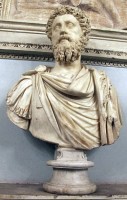
Marcus Aurelius Antoninus(121-180) - Roman emperor from the Antonin dynasty, philosopher, follower of Epictetus (ancient Greek philosopher; slave in Rome, then a freedman; founded a philosophical school in Nikopol).
Marcus Aurelius was the last of the five good emperors. The five good emperors are the five consecutive Roman emperors from the Antonine dynasty: Nerva, Trajan, Hadrian, Antoninus Pius, Marcus Aurelius. During their reign, characterized by stability and lack of repression, the Roman Empire reached its highest peak.
Marcus Aurelius received an excellent education. At the age of 25, he began to study philosophy under the guidance of Quintus Junius Rusticus. There is information about other philosophers called for him to Rome.
Marcus Aurelius learned a lot from his foster father, Antoninus Pius, who always stressed his respect for the Senate as an institution and for the senators as members of that institution.
Marcus Aurelius paid much attention to legal proceedings. In Athens, he established four chairs of philosophy for each of the philosophical trends that dominated his time: academic, peripatetic, stoic, epicurean. The professors were assigned state support. Just as under his predecessors, the institution of supporting children of low-income parents and orphans through the financing of alimentary institutions was preserved.
Aurelius, who did not have a warlike character, had to participate in hostilities.
In 178, Marcus Aurelius led a successful campaign against the Germans, but the Roman troops were overtaken by a plague epidemic. March 17, 180 Marcus Aurelius died of the plague in Vindobona on the Danube (modern Vienna).
After his death, Marcus Aurelius was officially deified. The time of his reign is considered in ancient historical tradition golden age. Marcus Aurelius is called "the philosopher on the throne". He professed the principles of stoicism (firmness and courage in life's trials), and the main thing in his notes is ethical teaching, an assessment of life from a philosophical and moral side and advice on how to relate to it.
Statue of Marcus Aurelius
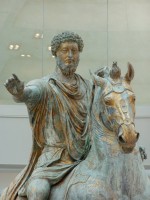
The bronze ancient Roman statue is located in Rome in the New Palace of the Capitoline Museums. It was created in the 160-180s, and was found in the Renaissance.
This is the only equestrian statue that has survived from antiquity. In the Middle Ages, it was believed that she depicts Emperor Constantine I the Great, whom the Christian Church canonized as "Saint Equal to the Apostles." This is what saved the monument, because. sculptures of pre-Christian rulers were considered pagan idols and were subject to destruction.
Initially, the equestrian statue of Marcus Aurelius was installed on the slope of the Capitol opposite the Roman Forum. Roman forum- a square in the center of ancient Rome, along with adjacent buildings. Initially, it housed a market, later it included a comitium (a place for public meetings), a curia (a meeting place for the Senate) and acquired additional political functions. This area served as the center of social life.
In the XII century. the statue was moved to the Lateran Square. In the XV century. the Vatican librarian Bartolomeo Platina compared the images on the coins and recognized the identity of the rider - he was Marcus Aurelius. In 1538, by order of Pope Paul III, she was placed on the Capitol. The plinth for the statue was made by Michelangelo - in the same year, under the leadership of the great Michelangelo Buonarroti, the reconstruction of the Capitoline Square began, which lasted more than 120 years and turned into a beautiful architectural ensemble, one of the main attractions of Rome.
The statue is simple in design and composition. Marcus Aurelius is depicted in a soldier's cloak over a tunic, but without weapons. The right hand, with the gesture of a speaker addressing the army, indicates that this is a triumphal monument erected on the occasion of the victory. However, this gesture can be understood as being generous towards the vanquished.
At the same time, Marcus Aurelius is depicted as a philosopher-thinker. He is wearing a tunic, a short cloak, and sandals on his bare feet. The face of Marcus Aurelius is individual, which was typical for Roman sculpture of that time, although somewhat idealized. Thick curly hair and a rather long beard are made in deeply incised, large curls. The head is slightly tilted forward, the lips are tightly compressed. The eyes, as in other portraits, are half-closed.
Under the raised hoof of the horse, there used to be a sculpture of a bound barbarian - a symbol of a defeated enemy.
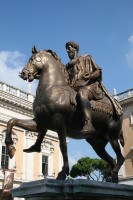
A copy of the sculpture in Capitoline Square






